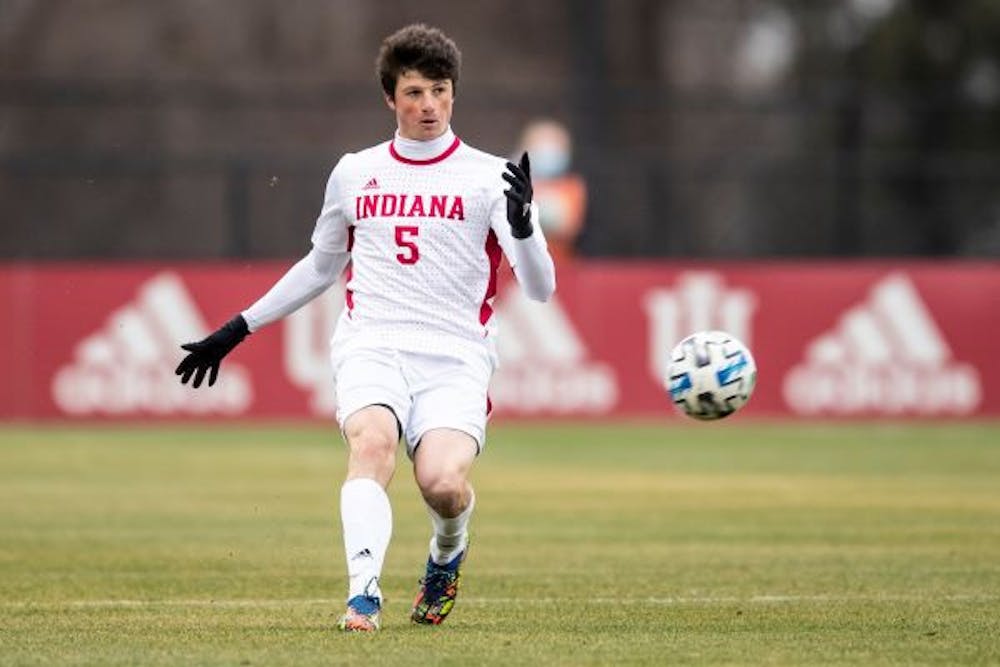Repeat after me: rankings and results don’t matter right now.
No. 9 Indiana and No. 16 Akron played to a 1-1 draw Friday night, moving IU to 3-1-1 on the season. But for a program that opened the season ranked second in the country and moved to first after just a week, this result will be viewed by many as a frustrating start.
But the draw brought many positives, and the next step is to carry this performance into Big Ten play next Friday. Akron is the best team Indiana has played this year, in terms of ranking, and the Hoosiers matched them in every aspect of the game, even in a hostile road environment.
The score line suggests a compact, cagey match between two top-20 teams not looking to expose themselves defensively. Under the surface, however, a combined 33 shots and two sensational goal-keeping performances from IU’s Roman Celentano and Akron’s Will Meyer made for a thrilling match between two teams who should make waves late in the season.
Indiana had the opportunities to win the match, though, and Indiana probably should have won the match.
All-American striker Victor Bezerra generated two great looks in the second half, both within 12 yards of Meyer in the Zips net, yet was denied twice. Senior captain Joe Schmidt played two great passes into the 6-yard box that didn’t find a Hoosier, yet were tap-ins if the runs were just a second or two earlier.
By leaving these chances on the table, after Daniel Munie flicked a Bezerra cross into the corner of the net to open the scoring, Akron was still in the match. Indiana’s lone defensive lapse allowed Diogo Pacheco to slide a shot past Celentano to level things up less than a minute after Munie’s goal in the 66th minute.
While it’s fair to criticize IU’s midfield’s reaction and restart after Munie’s goal -- which led to Akron’s equalizer -- it’s no surprise the best performance of the season from Schmidt and freshman Patrick McDonald coincided with Indiana’s best team performance.
Let’s get the bad out of the way first: Akron’s goal came from a delayed run by Pacheco, who found a pocket of space on the inside of the 18-yard box to slide a shot on frame. McDonald and Schmidt weren’t in position after the resumption of play, and left the defense out to dry.
Beyond that, Indiana dominated the midfield battle for large spells of the game. McDonald and Schmidt supported and covered any forays into the attack the other made, and showed marked improvement in their ability to handle the opposition in transition.
The role of Munie also continues to fascinate: after playing in midfield for a period of the Creighton match, he continues to regularly step out of the defense to operate as a defensive midfielder at times.
The shape of Indiana looked great, with Bezerra regularly pulling players into the match, Samuel Sarver’s movement continuing to impress, and Herbert Endeley having his best performance of the season in my eyes as well.
While a draw might not be the result IU or its fans were hoping for, the overall performance was certainly encouraging.
NON-CON SLATE: WHAT DID WE LEARN?
Head coach Todd Yeagley said earlier in the season he wanted to schedule tough opponents that would give Indiana different looks to open the campaign. The draw with Akron was Indiana’s last non-conference outing until October, with the start of Big Ten play less than a week away.
So, what have we learned from the five non-conference matches? Let’s go game by game:
The Notre Dame match was the Indiana of the spring season holding over: not particularly pretty, but did just enough to edge it on the day with a 3-2 overtime win. The emotion and excitement of Ben Yeagley’s golden-goal drowned out any real critiques of the opportunities Indiana conceded.
Butler felt the same, not particularly exciting, but handled a team with less talent and kept a clean sheet in a 1-0 win. But the red flags still existed: a goal-line clearance from Lawson Redmon and several great Celentano saves made the scoreline better than the match looked.
Then Creighton. Boy was that ugly. 3-0 loss, at home, with a huge crowd at Bill Armstrong Stadium behind the team. Though Bezerra was sidelined due to injury, the issues of the first two matches cropped up again, and Indiana didn’t have it in them to squeak it out on the day. After the match, Yeagley said that the reason for the leakiness of the defense escaped him. Indiana has talent, they have experience, yet they couldn’t stop conceding chances.
The 1-0 win to Xavier dispelled some concerns. The clean sheet was big, the attitude and effort was improved, yet it still was clearly Indiana with more potential to grow into.
Akron will wrap up the five matches nicely. Sure, five wins would be great, but Yeagley and his squad will benefit more from the lessons they’ve learned now, rather than when the result is all that matters. Defensively, Indiana looked better. 16 shots allowed is quite high on paper, but the actual quality of the chance, and Akron’s ability to break Indiana down was largely nullified.
Last season, Indiana won 12 of their 16 matches, and went to the National Championship. They did it by having the best attribute a team can have: they knew how to win.
But if Indiana is to truly evolve as a team, they won’t do the bare minimum to win: they’ll dominate en route to victory.
The signs and talent are there. Now it’s time to kick it into gear.
Indiana’s first five match to begin the season (since 2017):
2021: 3-1-1
2020-21: 4-1-0
2019: 3-0-2
2018: 4-1-0
2017: 4-0-1





